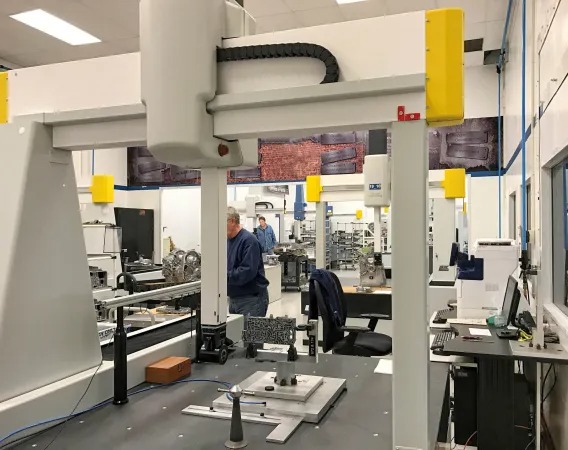At the US transmission plant of a global automotive manufacturing group, component inspection times have been reduced by half or more following the decision to partner with LK Metrology which has upgraded all of the CNC coordinate measuring machines (CMMs) on site to use 5-axis scanning technology. The Brighton, Michigan-based metrology company, US subsidiary of British CMM manufacturer LK Metrology Ltd, built 19 of the 26 CMMs in use at the US factory. Two are on the shop floor, while the others are installed in five different quality control (QC) rooms.
A spokesperson at the world class manufacturing centre explained, “We have been using LK machines for controlling the quality of our machined components for more than two decades. They have proved to be a reliable supplier and their ceramic-bridge machines are very accurate.”
 The impetus for investing in the metrology upgrade, where four- and six-speed transmissions have historically been manufactured, was the addition of eight- and nine-speed versions. Since then, electric hybrid transmissions have also entered production. It put the inspection team under pressure to cope with the increased throughput, so the company ordered extra LK machines and decided to also award the site-wide, turnkey REVO upgrade project to LK Metrology.
The impetus for investing in the metrology upgrade, where four- and six-speed transmissions have historically been manufactured, was the addition of eight- and nine-speed versions. Since then, electric hybrid transmissions have also entered production. It put the inspection team under pressure to cope with the increased throughput, so the company ordered extra LK machines and decided to also award the site-wide, turnkey REVO upgrade project to LK Metrology.
The spokesperson added, “LK had been pro-actively offering the conversion, but we needed to satisfy ourselves that our other CMMs could be similarly modified. Our engineers proved it could be done on a small, non-LK machine at another of our plants. The results showed how fast the REVO process is, while being just as precise as the touch probing method we have traditionally employed.
“Some machined features on our transmission components need to be held within ± 30 microns true position. To achieve this level of accuracy, it is essential for us to be able to hold single-figure micron tolerances on other dimensions, as tolerance build-up is inevitable. Obviously we need to measure those features and REVO on our CMMs allows us to do that quickly and accurately.”
Jobs Swapped Between CMMs in Minutes
About 1,500 steel and aluminium parts per day are inspected, some being the same item but at different stages of manufacture. Overall, 200,000 features have to be checked daily. The benefit of the present metrology set-up is that each of the five QC rooms houses identical technology and capability, with fixtures and probes freely interchangeable. So any operator can flexibly transfer jobs between CMMs around the site within minutes and it feels like he or she is using the same machine, a level of commonality that delivers highly consistent results. Previously this would not have happened, as the disparate measuring platforms within the facility meant that it would have taken hours or even days to move parts around for checking.
The speed of the new process for QC has not only saved time but also money, as without the technology extra CMMs would have been needed to cope with the ever increasing throughput. For the same reason there is a saving in overall CMM footprint, releasing floor space for other uses. Both scanning and touch-trigger probing routines are applied using the REVO system, the former being faster for sections of an inspection cycle to which it is suited.
The efficiency of the quality function at the facility is now such that there is capacity to help other transmission production centres nearby. When required, checks are also carried out to ensure the conformance of parts delivered by first-tier suppliers or produced by the group’s other manufacturing plants in the US and globally.
The Benefits of Scanning
The scanning system is Renishaw’s REVO, a two-axis CNC head that moves in unison with the three CNC axes of the CMM under program control to provide full 5-axis inspection, collecting dimensional data accurately using a tactile stylus. It can measure discrete points on a component in a conventional manner but is also able to scan over some areas, where it is expedient, to collect data at much higher speeds without leaving the surface. It is this latter feature that has on average halved cycle times at the US transmissions manufacturer.
Controlled by Renishaw’s MODUS software, the dexterous head with its two rotary CNC axes minimises the linear acceleration and deceleration of the CMM’s large moving elements during a measuring routine, whether touch probing or scanning. It means that the three orthogonal axes move for the most part with constant velocity, allowing changes in component geometry to be followed without introducing dynamic errors. Programs are created either in teach mode using the same software or from a CAD model.
The spokesperson concluded, “The system works extremely well, so we get results faster. We are currently looking at the possibility of having LK retrofit the latest REVO-2 head to our CMMs, which would allow us to acquire information on the surface finish of components in the same CNC cycles. The need for dedicated test equipment to check surface roughness could then be reduced or even eliminated.
“The system would also enable a multi-sensor approach to our measurement, as it can incorporate non-contact inspection using a vision probe as well as tactile methodology, should we ever decide to go down that route.”
For more information: www.lkmetrology.com
Tags: 3d vina, 5 Axis CMM Technology Halves Inspection Times at Transmission Manufacturing Plant, hiệu chuẩn, hiệu chuẩn thiết bị, máy đo 2d, máy đo 3d, máy đo cmm, sửa máy đo 2d, sửa máy đo 3d, sửa máy đo cmm
